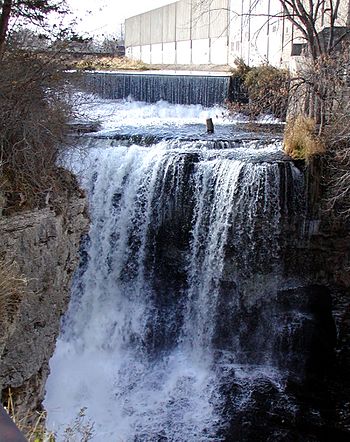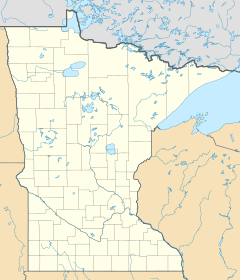Vermillion River (Minnesota) facts for kids
Quick facts for kids Vermillion River |
|
|---|---|

Vermillion Falls in Hastings
|
|
|
Mouth of the Vermillion River
|
|
| Country | United States |
| State | Minnesota |
| County | Goohue County, Dakota County, Scott County |
| Physical characteristics | |
| Main source | New Market, Minnesota 44°35′10″N 93°20′10″W / 44.5860751°N 93.3360562°W |
| River mouth | Welch, Minnesota 44°37′14″N 92°40′01″W / 44.6205230°N 92.6668629°W |
| Length | 59.6 mi (95.9 km) |
| Basin features | |
| River system | Mississippi River |
| Basin size | 335 sq mi (870 km2) |
| Tributaries |
|
| Waterfalls | Vermillion Falls |
The Vermillion River is a 59.6-mile (95.9 km) long waterway in Minnesota. It flows through Scott County and Dakota County. The river eventually joins the Mississippi River floodplain near Hastings. A special part of the river, about 13.5 miles (21.7 km) long, is known as a trout stream. This is quite rare for a river so close to a big city area like Minneapolis-Saint Paul.
Contents
What is the Vermillion River?
The name "Vermillion" comes from a French word meaning "red." It's believed the river was named this because of red ochre deposits. Native Americans used this red earth for body painting.
Fish and Wildlife in the River
The Vermillion River is special because it's a state-designated trout stream. This means it's managed for fishing, especially for brown trout. Anglers often practice catch-and-release fishing here.
The best places for trout are upstream, around the towns of Farmington, Empire, and Lakeville. Further downstream, near the town of Vermillion, the water gets warmer. This makes it less suitable for trout.
Below the Vermillion Falls in Hastings, the water becomes even warmer. Here, you can find different types of fish. These include river species like northern pike and freshwater drum. In 1940, the Minnesota state record for a black crappie was caught in the Vermillion River. It weighed 5.0 pounds!
Activities and History on the River
For many years, the Vermillion River was important for power. In the 1800s and early 1900s, its water helped run gristmills. These mills used the river's power to grind grain.
Historical Mills and Parks
Today, a park around the Vermillion Falls protects the old remains of a mill. This mill was once operated by Alexander Ramsey. He was a very important person in early Minnesota history. You can still see parts of the old mill building.
Protecting the River Today
Many groups work to keep the Vermillion River healthy. The Minnesota Trout Unlimited is a nonprofit group. Their volunteers have spent a lot of money and time restoring the river. They also work on the land next to it. They've completed four big projects with state grants.
The Twin Cities chapter of Trout Unlimited has a local volunteer group called the Vermillion Riverkeepers. These volunteers work with the Minnesota Department of Natural Resources. They help remove plants that don't belong there, like buckthorn. They also help with fish research and river restoration projects.
Another group, Friends of the Mississippi River, also helps. They organize cleanups and restoration events. They also offer educational activities through their Vermillion Stewards Program. These programs teach people how to care for the river.
Images for kids






